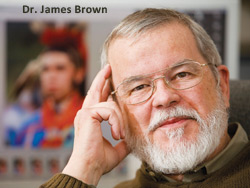University Communications and Marketing
Time and Displacement
March 31, 2008
Contacts:
Dan Carter, University Relations, 657-2269
Editor/photographer who chronicled history of Delaware Indians to speak at MSU Billings
MSU BILLINGS NEWS SERVICES — When Dr. James Brown undertook a journey to help chronicle the history of the Delaware Indians, he began his own voyage. It was one that would take 10 years, involve 10,000 photographs, cover a swath of the central United States and fill 416 hardcover book pages.
The end result is "Long Journey Home: Oral Histories of Contemporary Delaware Indians,"![]() a book that outlines efforts by current Delaware tribal leaders and members to preserve
a rapidly disappearing connection to their past.
a book that outlines efforts by current Delaware tribal leaders and members to preserve
a rapidly disappearing connection to their past.
“They were trying to recapture their lost culture,” said Brown. “And I’ll tell you… it was hanging by a thread.”
 Brown, a former National Geographic photographer and currently a journalism professor
at Indiana University, said he sees similarities to other Native American tribes who
— through mentorships with youth, education or cultural awareness campaigns — are
also trying to regain bits and pieces of their past.
Brown, a former National Geographic photographer and currently a journalism professor
at Indiana University, said he sees similarities to other Native American tribes who
— through mentorships with youth, education or cultural awareness campaigns — are
also trying to regain bits and pieces of their past.
Brown will talk about his observations and the process of producing “Long Journey Home” when he comes to Billings in early April. Brown will give two presentations — complete with a selection of his photos — at Montana State University Billings on Thursday, April 10 at the Student Union Building at 3:30 p.m. and Friday, April 11 at a noon lunch-and-learn session at the MSU Billings downtown campus. Both sessions are free and open to the public.
A compilation of first-hand reflections, family stories and the pursuit of a nearly lost heritage, “Long Journey Home” is a book about the Lenape, also known as the Delaware tribe. The oral histories in the book, which span a timeframe from the post-Civil War era to the present, are gathered into four sections and tell of personal and tribal events as they unfold over time and place.
The history of the Delaware tribe — an agricultural and fishing people when Europeans arrived in the 17th century — is one of continued forced displacement and adjustment. Through a series of treaties, the tribe was moved from their original tribal home along the eastern seaboard into Pennsylvania, continuing with a series of displacements in Ohio, Indiana, Missouri, Kansas and the Indian Territory in midwestern America. These days, home for the Delaware Indians is an area around Bartlesville, Okla.
 When Brown and co-editor Rita Kohn decided to capture this important part of American
history for posterity, they agreed to let the personal stories carry the book instead
of academic research and opinion.
When Brown and co-editor Rita Kohn decided to capture this important part of American
history for posterity, they agreed to let the personal stories carry the book instead
of academic research and opinion.
“That (using oral history) was purposeful on our part,” he said. “I’m an anglo, not an Indian. And I’m not an anglo pretending to be an Indian. We didn’t want the book to be our study of the Delaware, we wanted it to be their story.”
That story is one of trying to recapture a culture that was kept alive by personal memories and efforts, but was collectively on the edge of disappearance. Some tribal members, he said, were even “consigned to the fact that it’s a white man’s world” and didn’t try to preserve their culture.
Stories handed down through seven generations, however, have survived and are now compiled for posterity. One thread that runs through the book is that displacement from place does not diminish the power of personal memory or relationships.
As he quotes the reflections of tribal member Nora Dean: “It was like home being in New York, New Jersey, Delaware, Pennsylvania, Ohio, Indiana. And I’ve had that, when you’re there you know the history. That bloodline is in my veins, and I know that some of my ancestors had been there, that spirit is still there. It’s peaceful. When you’re there by yourself, and no one is around in the woods, you have that feeling. But things change. We moved, we blended in with society. Our tribe is Woodlands. When I went back and saw how huge the trees were, I was in awe. I loved it. If there is anything that I could have I’d want those huge trees down here in Oklahoma.”
In publicity for his book, Brown notes that common themes in the oral histories are remembrance; connections with ancestral traditions; loss and striving to retain culture despite U.S. policy to undermine tribal culture; the need to retain language; and above all, “the sense of being the Grandfather People with an abiding destiny to bring people together in harmony with the land and each other.”
Copies of Brown’s books will be available for purchase at both appearances at MSU Billings. He will also take in the MSU Billings Inter Tribal Indian Club’s annual powwow the weekend of April 11-12.
For more information on his presentations, please contact the Office of University Relations at 657-2269.
